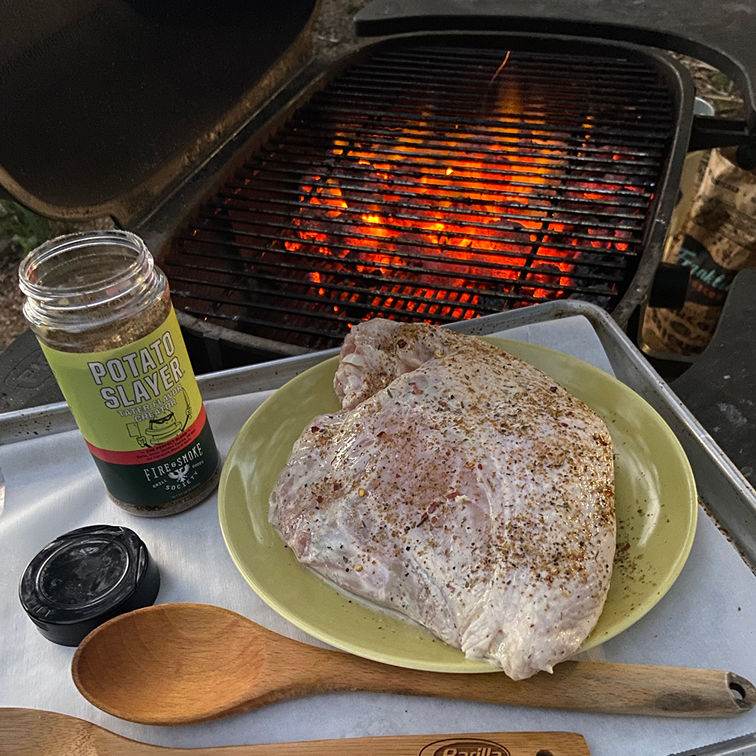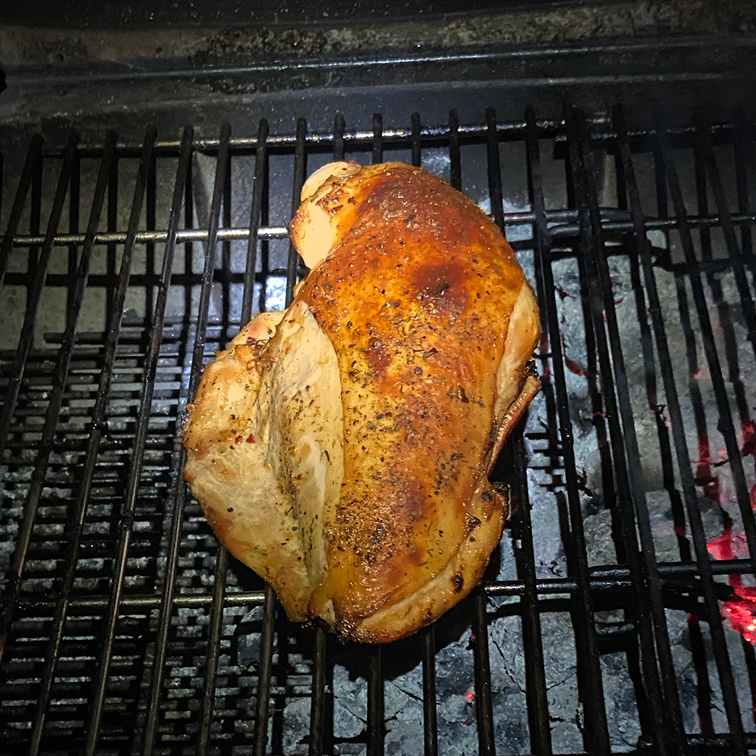Brining 101 + Buttermilk Brine Recipe
Posted by Paula Disbrowe on 16th Nov 2021

Brining 101 + Buttermilk Brined Turkey Breast
I’ll confess I’ve never been on Team Brine--until recently. That’s mainly because I’ve always achieved moist, flavorful results from grill-roasting turkey over a charcoal fire--especially when it’s spatchcocked and requires less cooking time. But 50,000 Elvis Fans can’t be wrong, and most experts and trusted chef friends agree that brining, in liquid or dry seasonings, improves a turkey’s ability to retain moisture and results in richer flavor. Nobody wants to serve a dry bird, so this year I dove into both methods.
Dry Brining: It’s just like it sounds--generously seasoning a turkey with salt and spices a couple days in advance. The salt tenderizes the meat, and helps to create a crispy, golden brown skin. Dry Brining also results in a more deeply seasoned and flavorful turkey than salting just before cooking. (Another benefit of dry brining? A bird in a sealable plastic bag takes up less space than a pot of brine.) When it comes to seasoning beyond salt (ratio below), follow your nose. I think The Usual tastes like the essence of Thanksgiving, so I’m partial to that blend; this year I paired it with Holy Garlic to give the meat garlicky depth. (The Usual + Chica Licka, The Usual + Sweet Peeper, Chica Licka + Holy Garlic, Chica Licka + Potato Slayer are all excellent combos).
Dry Brine Ratio: As a general rule, use 1 tablespoon of salt (or 1 tablespoon salted seasoning + ½ teaspoon salt) per 4 pounds of bird.
Wet Brining: This method calls for marinating a turkey overnight in a mixture of water (or other liquids), salt, and aromatics. Via osmosis, the bird absorbs added moisture from the brine, reducing the risk of dry meat. The most important ratio in a wet brine is the amount of salt per water; aim for approximately 1¼ cups salt per gallon. Beyond that equation, personal preference kicks in, with additions of sweeteners and aromatics (onions, garlic, spices, and fresh herbs sprigs).
Easy Wet Brine: Combine 1 ⅓ cups sugar and 1 ⅓ cup salt in a saucepan with a quartered onion, 2 tablespoons The Usual seasoning, 2 teaspoon coriander seeds, 2 teaspoons cracked black pepper, 6 fresh bay leaves and 4 thyme or sage sprigs with 4 cups water. Bring the mixture to a boil, whisking to dissolve sugar and salt. Stir in an additional 4 cups of water (or apple juice, cider, wine or beer); allow the mixture to cool to room temperature and you’re ready to brine. Add additional water as needed to submerge the bird.
The takeaway? It’s all about salt. Wet and Dry Brines both work, because salt breaks down muscle proteins, so they won’t contract while roasting (that means less tasty juice is muscled out of the bird). Wet brines infuse turkey with added moisture, but that plumping mostly comes from water, so there’s a risk of milder tasting meat. I’m mostly on team dry brine, because that method provides moist meat and deeply concentrated flavor, without changing the texture of the meat.
With the exception of a creamy liquid brine that delivered exceptional results--buttermilk.
Warning: The following recipe may forever change your relationship with deli meat.
Perhaps you can relate. With Thanksgiving just a few weeks out, I felt a restless need to jump start my turkey game. Plus, I’ve always wanted to try Samin Nosrat’s recipe for Buttermilk-Brined Turkey, a method featured in The New York Times a while back. The acid in buttermilk helps tenderize the meat, Nosrat explains, and the sugars help create a deeply flavored golden brown skin.
For me, buttermilk always conjures thoughts of ranch dressing, so I added herby Potato Slayer seasoning to the simple marinade. The following day, I grill-roasted the breast over a charcoal fire (indirect heat) for about 50 minutes. Some recipes call for roasting turkey at higher temperatures, but I think turkey, white meat in particular, benefits from a gentler heat, so I maintained a steady temp of 350℉.
This ridiculously easy method delivered extraordinary results. The breast was beautifully browned and exceptionally moist. As someone who thinks the best part of Thanksgiving is the day after sandwiches, I’ll be making this recipe well beyond the holiday season. You may never buy the deli stuff again.
Makes about 4 servings
Time: 1 hour, plus 24 to 36 hours brining time
2 cups buttermilk
2 tablespoons Potato Slayer seasoning, plus more for cooking
1 teaspoon finely ground sea salt


One or two days before you plan to cook, combine the buttermilk Potato Slayer seasoning and salt in a gallon-size resealable bag, and stir to dissolve the salt. Place the turkey breast in the bag and seal tightly, expelling all the air. Use your hands to squish the bag and distribute the brine evenly, and then refrigerate for 24-36 hours. (To ensure the entire cut gets evenly marinated, flip the bag a few times while it’s in the fridge.)
Two hours before you plan to grill, remove the turkey from the bag, and allow excess marinade to drip off the cut. Place the breast on a plate and allow it to come to room temperature.
Thirty minutes before you plan to grill, build a medium-high fire and prepare the grill for two-zone cooking. Clean and oil the grill grates. Season the turkey breast with a light sprinkle of Potato Slayer. When the coals are glowing red and covered with a fine gray ash, place the turkey breast skin-side up over indirect heat. Close the grill, vent the grill for smoking and cook until the thickest part of the breast registers 150℉ on an instant-read thermometer, about 50 minutes. Transfer the turkey to a rimmed baking sheet, tent with foil and allow it to rest for 30 minutes before carving.
